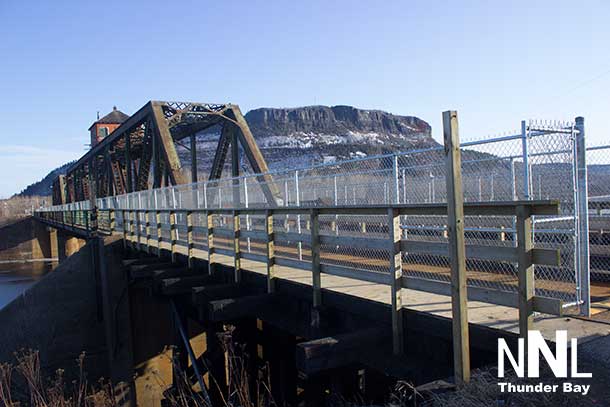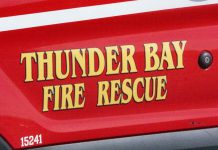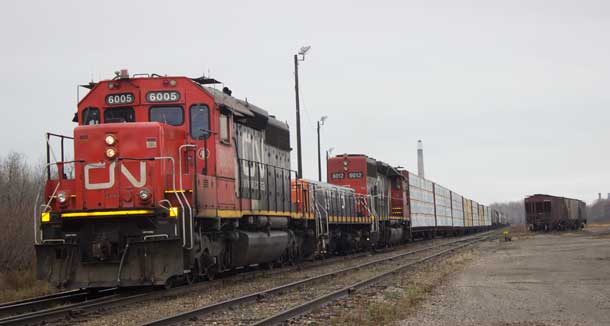
THUNDER BAY – NEWS – The James Street Bridge could be one step closer to re-opening. An Ontario Court of Appeal Justice has denied CN Rail a stay of the court ruling handed down earlier this year.
In a court ruling handed down on November 18, 2018, by Justice Simmons of the Court of Appeal for Ontario says, “The potential harm to CN is quantified at four to six million dollars if leave is granted and its appeal is ultimately successful. Balanced against that are the facts that CN contributed to the possibility of irreparable harm by failing to move more expeditiously for leave and that the potential for serious impacts on Thunder Bay and the First Nation increases the longer the reopening of the Bridge is delayed.
The Justice says in her ruling that “CN seeks a stay for an estimated period of about two months. It asserts that it has taken reasonable steps to comply with this court’s order and that it will continue to do so up until December 15, 2018 – the date on which it anticipates delivery of issued for construction drawings for reconstruction work it proposes to undertake. It estimates that a decision from the Supreme Court of Canada on its leave application would likely be forthcoming within about two months after December 15, 2018.”
CN has concerns that the cost of the repairs at $4-$6 million dollars could cause harm to the company.
This is a developing story and NetNewsLedger will be updating it.
COURT OF APPEAL FOR ONTARIO
CITATION: Thunder Bay (City) v. Canadian National Railway Company, 2018 ONCA 919
DATE: 20181116
DOCKET: M49452 (C64026)
Simmons J.A. (Motion Judge)
BETWEEN
The Corporation of the City of Thunder Bay
Applicant (Appellant/ Responding Party)
and
Canadian National Railway Company and Fort William First Nation
Respondents (Respondent / Moving Party and Responding Party)
Guy J. Pratte and Duncan A.W. Ault, for the moving party, Canadian National Railway Company
Christopher J. Matthews and Sanj Sood, for the responding party, The Corporation of the City of Thunder Bay
Samuel W. Crowe, for the responding party, Fort William First Nation
Heard: November 2, 2018
REASONS FOR DECISION
A. INTRODUCTION
[1] The Canadian National Railway Company moves for a stay of this court’s order made in June 2018, which required CN to reopen the James Street Bridge in Thunder Bay for vehicle traffic and maintain the Bridge in accordance with a 1906 agreement.
[2] CN owns the Bridge, which traverses the Kaministiquia River in Thunder Bay. Most of Thunder Bay lies to the north of the Bridge; the Fort William First Nation lies to the south.
[3] The Bridge was built under the terms of a 1906 agreement between the Grand Trunk Pacific Railway Company, a predecessor of CN, and the Town of Fort William, which was later amalgamated into the City of Thunder Bay.
[4] Under s. 3 of the 1906 agreement, Grand Trunk gave Fort William “the perpetual right to cross said bridge for street railway, vehicle and foot traffic”. Under s. 5, Grand Trunk agreed to “maintain the bridge in perpetuity”.
[5] The Bridge is unique in CN’s railway network, in that it is a combined railway, vehicle and pedestrian bridge. Single vehicle lanes straddle both sides of the centre railway line and a pedestrian sidewalk flanks the outside of each vehicle lane.
[6] Following a fire in 2013, CN closed the Bridge to vehicle traffic, claiming it was unsafe and could only be made safe through structural repairs that were beyond the scope of its maintenance obligation under the 1906 agreement. As matters developed, the key safety concern was that an errant vehicle could leave the roadway, cross the sidewalk – which could not bear its weight – and fall into the river.
[7] In 2017, Smith J. dismissed Thunder Bay’s application for a declaration that CN is obliged to maintain the Bridge in perpetuity and required to reopen the Bridge for vehicle traffic. He concluded that it was the intention of the parties to the 1906 agreement that the Bridge be maintained for the type of bridge traffic that existed when the agreement was made, namely streetcar and horse and cart traffic. Further, he found that CN had consistently taken the position that it was not obliged to make structural changes to the Bridge that would permit modern motor vehicle traffic. Finally, he concluded that Thunder Bay, as the applicant, had the onus to clearly define the relief it was seeking and the changes necessary to make the Bridge safe for motor vehicles and that it had failed to do so.
[8] On June 11, 2018, this court set aside the application judge’s order and made the order CN seeks to stay. Among other things, this court found that the application judge’s conclusion concerning the parties’ intentions was unreasonable and tainted by extricable errors of law. On its application of the principles of contractual interpretation, this court concluded that vehicle traffic in the 1906 agreement means any kind of vehicle traffic, including car and truck traffic. Further, CN was obliged to maintain the Bridge in perpetuity for any kind of vehicle that used it. Finally, this court held that the application judge erred by placing an onus on Thunder Bay to provide a proposal to make the Bridge safe for motor vehicles as it is up to CN to determine what maintenance is needed to alleviate any safety concerns.
[9] In reaching its conclusions, this court found that CN’s attempt to distinguish structural repairs from its maintenance obligation was both of little practical consequence and legally irrelevant – the latter because an action in which CN claimed a declaration that its contractual maintenance obligation was extinguished had been stayed.
[10] CN filed a notice of application for leave to appeal this court’s order to the Supreme Court of Canada on August 20, 2018. The application was subsequently completed in mid October. In its leave application, CN submits that this court’s decision raises two issues of public importance that warrant granting leave to appeal:
- Whether an appellate court can impose a perpetual maintenance obligation that it refuses to define without affording basic procedural fairness.
- Whether a minimal level of specificity is required for a mandatory order.
[11] On this motion, CN seeks a stay for an estimated period of about two months. It asserts that it has taken reasonable steps to comply with this court’s order and that it will continue to do so up until December 15, 2018 – the date on which it anticipates delivery of issued for construction drawings for reconstruction work it proposes to undertake. It estimates that a decision from the Supreme Court of Canada on its leave application would likely be forthcoming within about two months after December 15, 2018.
[12] Thunder Bay and the Fort William First Nation oppose the granting of a stay.
[13] For the reasons that follow, I decline to grant a stay.
B. BACKGROUND
(1) The 1906 Agreement
[14] The 1906 agreement was preceded by an agreement made in 1905 in which Grand Trunk and Fort William agreed to the construction of a branch line that would connect the Town to a transcontinental railroad. Section 6 of the 1905 agreement provided that Fort William would pay Grand Trunk a $50,000 bonus if Grand Trunk agreed to construct a bridge over the river and give the Town the perpetual right to cross the bridge “for street railway, vehicle and foot traffic”.
[15] Under the 1906 agreement, Grand Trunk agreed to build the Bridge. As noted above, s. 3 of the 1906 agreement gave Fort William the perpetual right to cross the Bridge for street railway, vehicle and foot traffic:
The Company will give the Municipal Corporation the perpetual right to cross said bridge for street railway, vehicle and foot traffic on roadways supported by brackets on each side of the railway bridge substantially as shown on Plate “C”, and this portion of the bridge shall be for the Town and any person or corporation authorized by the Town.
[16] Section 5 of the 1906 agreement set out Grand Trunk’s obligation to maintain the Bridge in perpetuity:
The Company will maintain the bridge in perpetuity without costs to the Town except the cost and maintenance of street car rails and trolley wires which will be furnished by the Town or Electric Railway Company using the bridge; and that the space allowed for Town traffic on each side of the bridge, be sufficient to accommodate street car, vehicular traffic and separate passage for foot passengers.
(2) The Bridge
[17] Construction of the Bridge was completed in 1909. Between 1909 and 2013 the Bridge operated for rail, vehicle and pedestrian traffic. After 1950, the vehicle lanes were no longer used for street railway; instead, they were used exclusively for vehicle traffic, including both car and truck traffic. Prior to closure, the speed limit on the Bridge was reduced to 20 km/h and three speed bumps were installed. As of 2007 (the most recent statistics available), annual daily traffic was estimated at 8,871 motor vehicles per day.
(3) CN closes the Bridge to vehicle traffic
[18] CN closed the Bridge on October 29, 2013 because of a fire. However, when it reopened the Bridge three days later, it reopened it only for trains and pedestrians, claiming it was not safe for motor vehicles. CN asserted that the Bridge could not be made safe for motor vehicles without structural changes – and it claimed it was not required to make structural changes under its obligation to maintain the Bridge in the 1906 agreement.
(4) The 2015 Litigation
[19] In February 2015, CN issued a statement of claim in which it claimed, among other things, declarations that it was not contractually obligated to reopen, rebuild or replace the roadway bridge and that any obligation to maintain the roadway bridge had been extinguished. Three days later, Thunder Bay issued an application, naming both CN and Fort William First Nation as respondents, in which it sought, among other things, a declaration that CN is obliged to maintain in perpetuity a combined railway and highway bridge and that such obligation includes maintaining the bridge to current standards and regulations. Thunder Bay also sought an order staying CN’s action or, in the alternative, consolidating the two proceedings.
(5) CN’s action is stayed
[20] On January 20, 2016, Fregeau J. stayed CN’s action, holding that it was appropriate that the matter proceed by way of Thunder Bay’s application.
(6) Thunder Bay’s application is dismissed
[21] On June 9, 2017, the application judge dismissed Thunder Bay’s application based on his interpretation of the 1906 agreement. He concluded, based on the words used, the subsequent conduct of the parties and the context in which the agreement was made, that it was the intention of the parties that CN would maintain the Bridge for the type of bridge traffic that existed at the time of the 1906 agreement, namely streetcar and horse and cart traffic.
[22] Further, the application judge found that the record did not support Thunder Bay’s position that CN had maintained the Bridge to the extent of making structural changes necessary to comply with modern safety codes.
[23] Finally, the application judge concluded that Thunder Bay had the onus of clearly defining the relief it was seeking and of providing cogent evidence of the changes necessary to make the Bridge safe for motor vehicles and that it had failed to do so. He said that without such evidence, it was not possible to determine whether the work required to open the Bridge safely was within the scope of what was intended by the parties when they signed the 1906 agreement.
(7) This court orders CN to reopen the Bridge
[24] In its June 11, 2018 judgment, this court set aside the application judge’s decision. This court held that, under the 1906 agreement, vehicle traffic means any kind of vehicle traffic, including car and truck traffic. Accordingly, at para. 69 of its reasons, this court stated:
Under the Agreement cars and trucks have a perpetual right to cross the Bridge, and to ensure that right is preserved, CN has a corresponding obligation to keep open and maintain the Bridge in perpetuity. To terminate its obligation CN would have to seek a court order that its obligation to maintain is incapable of being performed.
[25] This court held that CN breached the 1906 agreement by failing to reopen the Bridge for motor vehicle traffic. Further, it found that CN is obliged to reopen the Bridge for vehicle traffic and to determine what maintenance is needed to alleviate any safety concerns.
[26] In reaching these conclusions, this court held that the application judge’s finding concerning the parties’ intentions regarding the use of the Bridge was unreasonable and tainted by extricable legal error.
[27] In particular, the application judge’s finding was unreasonable because it failed to take account of the full context in which the 1906 agreement was made, was contrary to the parties’ reasonable expectations, and was at odds with the express words of the 1906 agreement.
[28] Further, the finding was tainted by two extricable legal errors.
[29] First, the application judge failed to give any effect to the words “perpetual” and “in perpetuity”. Second, the application judge erred in taking into account the parties’ subsequent conduct when the meaning of the 1906 agreement was not ambiguous. Alternatively, even if the meaning was ambiguous, the application judge failed to consider the parties’ relevant subsequent conduct.
[30] Finally, this court concluded that the application judge erred by placing an onus on Thunder Bay to provide a proposal to make the Bridge safe for motor vehicles.
[31] In the context of discussing these errors, this court found the distinction CN sought to draw between maintenance obligations and structural repairs of little practical consequence and legally irrelevant.
[32] The distinction was of little practical consequence because the maintenance CN had performed until 2013 had been sufficient to allow cars and trucks to safely cross the Bridge prior to its closure. It was undisputed that the fire caused minimal damage to the Bridge. Instead, the key safety issue that CN had identified was the risk of an errant vehicle leaving the roadway, crossing the sidewalk and falling into the river. However, that risk had never manifested itself in over 100 years of operation and was minimized by the speed limit and speed bumps on the Bridge.
[33] The distinction was legally irrelevant because it was, in substance, an argument that CN should be relieved of its obligation to maintain the Bridge – relief CN had claimed in its action – and its action had been stayed.
C. THE TEST FOR GRANTING A STAY
[34] The basic test for granting a stay pending leave to appeal is the same as the test for granting an interlocutory injunction. The moving party must demonstrate: i) a serious issue to be adjudicated on appeal; ii) that it will suffer irreparable harm if a stay is not granted; and iii) that the balance of convenience favours granting a stay: see Yaiguaje v. Chevron Corporation, 2014 ONCA 40(CanLII), 315 O.A.C. 109, at para. 3; RJR-MacDonald Inc. v. Canada (Attorney General), 1994 CanLII 117 (SCC), [1994] 1 S.C.R. 311, at p. 314.
[35] However, these factors are not “watertight compartments”; the strength of one factor may compensate for the weakness of another. Overall, the court must decide whether, taking all relevant considerations into account, the interests of justice warrant granting a stay: Circuit World Corp. v. Lesperance (1997), 1997 CanLII 1385 (ON CA), 33 O.R. (3d) 674 (C.A.), at p. 677.
[36] Although ordinarily the threshold for establishing a serious issue to be adjudicated is low, the criteria for granting leave to the Supreme Court of Canada add another layer to the test: BTR Global Opportunity Trading Ltd. v. RBC Dexia Investor Services Trust, 2011 ONCA 620 (CanLII), 283 O.A.C. 321, at para. 16.
[37] Under s. 40(1) of the Supreme Court Act, R.S.C. 1985, c. S-26 leave may be granted where any question involved is one that ought to be decided by the Supreme Court by reason of its public importance or the importance of any issue of law or any issue of mixed fact and law or for any other reason of such a nature and significance as to warrant a decision by the Supreme Court.
[38] The stay test requires that a judge hearing a stay motion consider not only whether the proposed appeal raises a serious issue to be adjudicated under RJR-Macdonald. The judge must also consider the factors in s. 40(1) and assess whether there is some merit in the leave application: Yaiguaje, at para. 4.
D. DISCUSSION
(1) Serious issue to be adjudicated and s. 40(1) criteria
[39] I conclude it is unlikely that CN will succeed in its application for leave to appeal to the Supreme Court of Canada.
[40] As noted above, CN submits this court’s decision gives rise to two issues of public importance that warrant granting leave:
- Whether an appellate court can impose a perpetual maintenance obligation that it refuses to define without affording basic procedural fairness.
- Whether a minimal level of specificity is required for mandatory order.
(a) The maintenance obligation
[41] Concerning the first issue, CN submits that the imposition of a maintenance obligation unbounded in scope and duration is a departure from established jurisprudence holding that maintenance obligations should be constrained. It contends that this court’s decision thus creates uncertainty in contracts and statutory provisions under which parties are obliged to provide (or enjoy the benefit of) maintenance. Further, CN submits that this court imposed this maintenance obligation by erroneously finding that its scope was irrelevant to the proceeding because of a stay imposed in relation to CN’s original action against Thunder Bay. CN says this finding was contrary to both parties’ position that determining the scope and content of the maintenance obligation was a key issue to be decided. Moreover, the finding of irrelevance based on the prior order for a stay deprived CN of procedural fairness because the issue was never raised in argument nor did the court afford CN an opportunity to address it.
[42] As a starting point, I see little merit in CN’s submissions about the scope of maintenance obligations and the impact of this court’s decision on other contracts or statutory provisions imposing maintenance obligations.
[43] It was the 1906 agreement, not this court, that created a perpetual right to cross the Bridge and that imposed a maintenance obligation in perpetuity.
[44] This court’s interpretation of the 1906 agreement was driven by established principles of contractual interpretation, including: (1) an analysis of the contextual factors relating to the formation of the contract (the purpose of both the 1905 and 1906 agreements, the reasonable expectations of the parties in entering into the 1906 agreement and the coming of the automobile era), (2) the language of the 1906 agreement (including the use of the terms “perpetual” and “in perpetuity”) and, (3) the fact that, if subsequent conduct was relevant, which this court concluded it was not, CN had been able to make repairs and upgrades falling within its acknowledged maintenance obligation sufficient to allow cars and trucks to safely cross the Bridge for many years.
[45] As noted by CN in its appeal factum in this court, the Supreme Court of Canada has held “that a contractual maintenance obligation varies according to the specific terms of each contract”: Thunder Bay (City) v. Canadian National Railway Company, 2018 ONCA 517 (CanLII), 424 D.L.R. (4th) 588 (Factum of the Respondent at para. 65).
[46] Thus, rather than being a departure from existing jurisprudence, this court’s interpretation is consistent with it. Moreover, I fail to see how this court’s interpretation of the specific provisions of this rather unique contract is likely to have an impact on the interpretation of other contracts or statutes.
[47] Similarly, I see little merit in CN’s arguments that this court erred in finding that the distinction CN draws between its maintenance obligation and making structural changes to the Bridge was irrelevant in the context of the within proceeding.
[48] As I have said, CN makes two points in this regard. First, CN argues this finding was contrary to both parties’ position that determining the scope and content of the maintenance obligation was a key issue to be determined. I reject this submission. In its factum filed on the appeal to this court, Thunder Bay took the position that “CN’s stance in this litigation is akin to a party seeking to rely on the doctrine of frustration to excuse its breach of contract”: Thunder Bay (City) v. Canadian National Railway Company(Factum of the Appellant at para. 86).
[49] That is the precise basis on which this court concluded that the distinction CN sought to draw between maintenance and structural changes is irrelevant in this proceeding. This court also noted that the application judge did not make a finding that the 1906 agreement was at an end and stated at para. 59, “nor could he.” Further, this court stated the application judge did not even make a finding that CN was incapable of performing its contractual obligation. In adopting Thunder Bay’s submission, this court concluded that CN was seeking to be relieved from its contractual obligation based on a claim (frustration) it had not formally advanced.
[50] CN’s second point is that this court’s finding concerning the effect of the 2016 stay of its action deprived it of procedural fairness because the effect of the 2016 stay order was never raised during argument of the appeal. Nor did the court afford CN an opportunity to address the effect of the 2016 stay order.
[51] Even assuming the specific argument about the effect of the 2016 stay order on which this court relied was never raised, the fact remains, as Thunder Bay pointed out during this motion, that CN did not advance a claim to be discharged from its contractual obligations in this proceeding by way of counter-application. In addition to pointing to the 2016 stay order, this court was clear in stating, at para. 69 of its reasons, that, to be discharged from its contractual obligation, CN would require a court order that its obligation to maintain is incapable of being performed – in other words, that this aspect of the 1906 agreement is frustrated. I see nothing procedurally unfair about CN being precluded from advancing arguments relevant to a claim it did not advance.
[52] In the circumstances, if this ground of appeal surpasses the serious issue threshold, it does so barely.
[53] In any event, this is not the type of case in which the Supreme Court of Canada is likely to grant leave to appeal. As I have said, this case involves the interpretation of a private contract in which established legal principles were applied. It is therefore not the type of case in which the Supreme Court typically grants leave to appeal. For the reasons I have explained, I do not accept CN’s argument that this court’s interpretation of CN’s maintenance obligation in the 1906 agreement is likely to have far-reaching implications on the interpretation of other contracts or statutory provisions.
(b) The Mandatory Order
[54] Concerning the second issue, CN asserts that this court erred by ordering CN to reopen and maintain the Bridge without giving any direction as to when the Bridge is to be reopened, how the Bridge is to be maintained or what the duty to maintain consists of. CN submits this is inconsistent with existing jurisprudence on both maintenance obligations and mandatory orders. It says guidance from the Supreme Court is required where this court has refused to interpret the content or scope of the key obligation a party is ordered to perform, thus leaving the content and scope of the maintenance obligation unlimited and potentially exposing CN to contempt proceedings.
[55] As I see it, the flaw in this argument is that this court’s order does no more than order CN to continue performing a contract that it had been performing, without apparent difficulty, for more than 100 years. This court interpreted the 1906 agreement as creating a perpetual right for cars and trucks to cross the Bridge and as creating a corresponding obligation on CN to open and maintain the Bridge in perpetuity to allow that to happen. This court stated that to terminate that obligation, CN would have to seek a court order that its obligation to maintain is incapable of being performed – which CN did not do. Accordingly, this court did no more than order CN to continue doing what it knew how to do and had successfully done for more than 100 years.
[56] Even assuming this issue gives rise to a serious question to be adjudicated, I conclude this is not the type of case in which the Supreme Court is likely to grant leave to appeal for the same reasons I reached that conclusion in relation to the first issue.
(2) Irreparable Harm
[57] I am satisfied that CN would suffer irreparable harm in the following circumstances: i) a stay is not granted; ii) the Supreme Court does not deliver its decision on the leave motion before the date on which CN is in a position to undertake the tendering process in relation to proposed reconstruction work; and iii) CN is ultimately successful in its appeal.
[58] As noted above, since this court’s decision was delivered, CN has undertaken certain steps towards doing the work it considers necessary to enable it to reopen the Bridge. More specifically, CN sought proposals from three engineering firms and entered into an agreement with one of those firms. Under that agreement, the selected engineering firm has provided a report on alternatives and will deliver issued for tender drawings by November 15, 2018 and issued for construction drawings by December 15, 2018.
[59] After December 15, 2018, presumably CN will have to arrange for tender documents to be prepared and thereafter undertake the tendering process. CN submits the latter step could lead to irreparable harm because CN would become contractually committed to paying for the reconstruction work for which it invites bids. CN has an estimate for this cost at between four and six million dollars. I accept CN’s submission that if its leave application and appeal are ultimately successful, it is doubtful that CN would have any recourse against Thunder Bay for this amount.
[60] Thunder Bay responds that it would be open to CN to make its tender and any contract conditional on denial of the request for leave to appeal. However, Thunder Bay provided no support for its submission that such a conditional tender would be practically feasible.
[61] As a matter of common sense, bidders are unlikely to expend the time and money to submit a serious bid where a condition means the project may never proceed.
[62] A review of a number of cases relating to tenders provides no support for the proposition that making a contract conditional on denial of a request for leave to appeal is likely to be practically feasible: Surespan Construction Ltd. v. Saskatchewan, 2013 SKQB 23 (CanLII), 10 B.L.R. (5th) 117; Trevor Nicholas Construction Co. v. Canada (2000), 2 C.L.R. (3d) 176 (F.C.T.D.); Foundation Building West Inc. v. Vancouver (City) (1995), 22 C.L.R. (2d) 94 (B.C.S.C.); Admiral Roofing Ltd. v. Prince George School District No. 57, 2010 BCSC 1394 (CanLII), 85 B.L.R. (4th) 87; G.J. Cahill & Co. (1979) v. Newfoundland & Labrador, 2005 NLTD 129 (CanLII), 250 Nfld. & P.E.I.R. 145; St. Lawrence Cement Inc. v. Ontario (Minister of Transportation) (1991), 1991 CanLII 7108 (ON SC), 3 O.R. (3d) 30, 50 B.L.R. 319 (Ct. J. (Gen. Div.). Unlike Thunder Bay’s proposal, the conditions found in these cases do not negate the possibility the project will proceed.
[63] Thunder Bay also argued that it was up to CN to show that a conditional tender is not feasible. I reject that submission. In my view, Thunder Bay’s proposal lacks an air of reality; I see nothing for CN to negate.
(3) The Balance of Convenience
[64] As I have said, I am satisfied CN may suffer irreparable harm in the form of incurring financial commitments for which it will not be compensated if a stay is not granted and CN ultimately succeeds on its appeal.
[65] On the other hand, Thunder Bay and the Fort William First Nation have filed evidence that the 10-kilometre detour vehicular traffic must make because of the Bridge closure causes more than inconvenience. They contend it creates higher risks to motorists using the detour route because of significantly increased traffic, increased response times for emergency personnel coming to the First Nation from Thunder Bay, and negative financial consequences for the First Nation economy. Further, in the event of a road closure on the alternate route, the First Nation becomes temporarily inaccessible by road. Thunder Bay also raises the spectre that even a two-month interruption in CN’s planned reconstruction effort could have the impact of delaying reopening of the Bridge from the current schedule of sometime in 2019 to the spring of 2020 or later, because construction cannot occur during winter weather.
[66] While I have no doubt that the Bridge closure has had negative impacts beyond inconvenience during the more than five years it has been closed, I find the evidence of specific financial impacts unreliable. Further, I observe that there is no evidence before me concerning the cause of the accidents on the detour route on which Thunder Bay and the First Nation rely. I observe as well that Thunder Bay waited almost a year and five months before bringing its application to obtain a remedy for the Bridge closure. Although it appears Thunder Bay was attempting to negotiate a resolution with CN, the fact of this lengthy delay diminishes the force of the arguments about harm. Moreover, the expected delay between December 15, 2018 and the anticipated date of a decision on the leave application is relatively short – likely no more than two months. I do however acknowledge that, in any particular case, delay in emergency response times could lead to catastrophic results.
[67] To these considerations, I add the observation that had CN filed its leave application more expeditiously, the requirement for a stay may not have arisen. This court’s decision was released on June 11, 2018; CN took until August 20, 2018 to file its leave application. Although I cannot characterize such a delay as unreasonable in the abstract, in my view, it does not reflect the conduct of a litigant concerned about irreparable harm and for whom time is of the essence. To that extent, I consider that CN has contributed to the situation it is in.
[68] Finally, the evidence relevant to the impact of an estimated two-month delay in tendering on the timing of the eventual reopening of the Bridge does not make it clear that the delay in reopening the Bridge will be restricted to two months. Based on evidence that the reconstruction CN proposes could take four to eight months and the uncontested fact that winter weather can impact construction, I cannot be satisfied that granting the stay would not have the effect of delaying the reopening of the Bridge until 2020 if leave is not granted. As CN is seeking a stay, it had the onus of demonstrating the extent to which granting the stay would delay the reopening of the Bridge.
[69] Overall, I conclude that the balance of convenience favours CN, but only modestly. The potential harm to CN is quantified at four to six million dollars if leave is granted and its appeal is ultimately successful. Balanced against that are the facts that CN contributed to the possibility of irreparable harm by failing to move more expeditiously for leave and that the potential for serious impacts on Thunder Bay and the First Nation increases the longer the reopening of the Bridge is delayed.
(4) The Interests of Justice Do Not Favour Granting a Stay
[70] Overall, I am not satisfied that the interests of justice favour granting a stay. The second and third factors favour CN. Nonetheless, I am not satisfied CN’s leave application has sufficient merit to warrant granting a stay. In my view, CN has not identified a serious issue to be adjudicated that meets the criteria for granting leave under s. 40 of the Supreme Court Act. I conclude it is not reasonably arguable that CN will obtain leave.
E. DISPOSITION
[71] CN’s motion for a stay is dismissed. If the parties are unable to agree on costs, Thunder Bay and the First Nation may make brief submissions, not to exceed three pages, within 10 days from the release of these reasons; CN may respond within 10 days thereafter.
“Janet Simmons J.A.”






